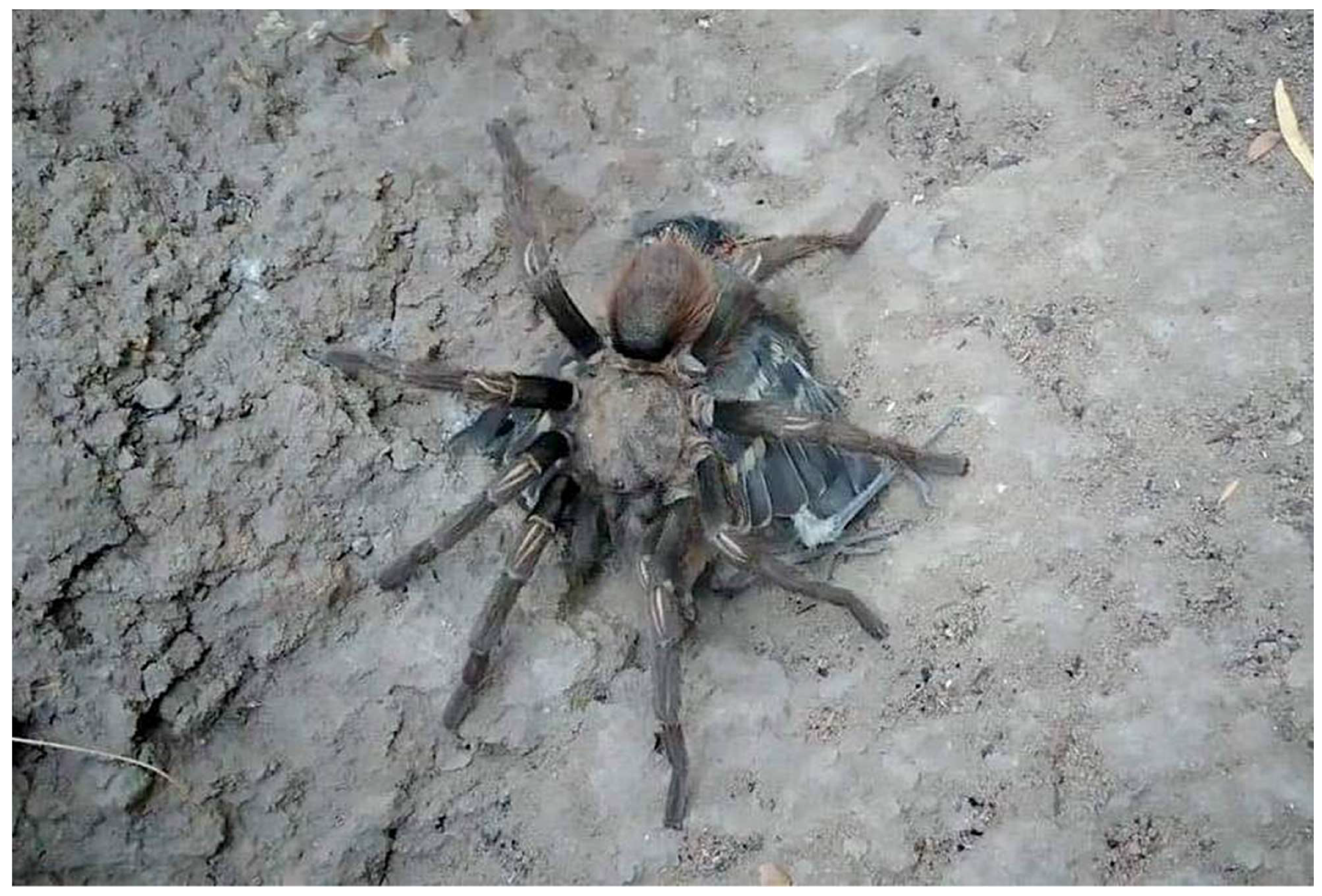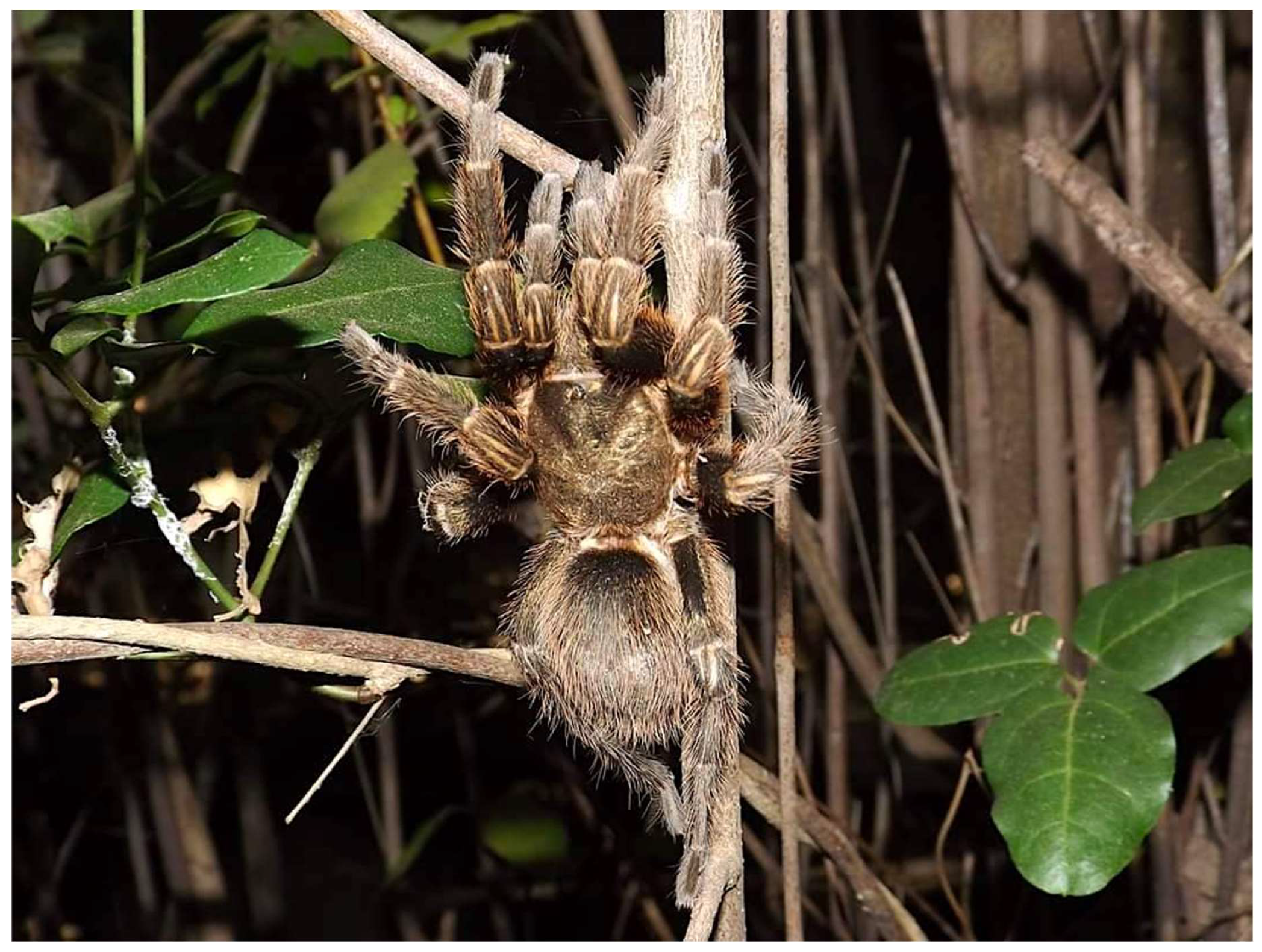First Predation Record of a Tarantula (Euathlus sp., Theraphosidae) on a Juvenile Austral Thrush (Turdus falcklandii, Turdidae) in Central Chile
Abstract
:Author Contributions
Funding
Institutional Review Board Statement
Informed Consent Statement
Data Availability Statement
Acknowledgments
Conflicts of Interest
References
- Valdez, J.W. Arthropods as vertebrate predators: A review of global patterns. Glob. Ecol. Biogeogr. 2020, 29, 1691–1703. [Google Scholar] [CrossRef]
- Reyes-Olivares, C.; Guajardo-Santibañez, A.; Segura, B.; Zañartu, N.; Penna, M.; Labra, A. Lizard predation by spiders: By review from the Neotropical and Andean regions. Ecol. Evol. 2020, 10, 10953–10964. [Google Scholar] [CrossRef] [PubMed]
- Copperi, S.; Ferretti, N.; González, A.; Pérez-Miles, F.; Pompozzi, G. Arañas migalomorfas: ¿simpáticas mascotas o aterradores peligros? Cienc. Hoy 2011, 21, 36–43. [Google Scholar]
- McCormick, S.; Polis, G.A. Arthropods that prey on vertebrates. Biol. Rev. 1982, 57, 29–58. [Google Scholar] [CrossRef]
- Greene, H.W. Antipredator mechanisms in reptiles. In Biology of the Reptilia: Volume 16. Ecology B. Defense and Life History; Gans, C., Huey, R.B., Liss, A.R., Eds.; Academic Press: New York, NY, USA, 1988; pp. 1–152. [Google Scholar]
- Das, K.S.A.; Sreekala, L.K.; Abdurahiman, O. Predation on the Kelaart’s Pipistrelle Bat, Pipistrellus ceylonicus Kelaart (Chiroptera: Vespertilionidae), by the Reddish Parachute Tarantula, Poecilotheria rufilata Pocock (Araneae: Theraphosidae), in Chinnar Wildlife Sanctuary, Kerala, India. Trop. Nat. Hist. 2012, 12, 257–260. [Google Scholar]
- Nyffeler, M.; Knörnschild, M. Bat predation by spiders. PLoS ONE 2013, 8, e58120. [Google Scholar] [CrossRef] [PubMed] [Green Version]
- Nyffeler, M.; Pusey, B.J. Fish predation by semiaquatic spiders: A global pattern. PLoS ONE 2014, 9, e99459. [Google Scholar]
- Von May, R.; Biggi, E.; Cárdenas, H.; Isabel Diaz, M.; Alarcón, C.; Herrera, V.; Santa-Cruz, R.; Tomasinelli, F.; Westeen, E.P.; Sánchez-Paredes, C.M.; et al. Ecological interactions between arthropods and small vertebrates in a lowland Amazon rainforest. Amphib. Reptile Conserv. 2019, 13, 65–77. [Google Scholar]
- Hénaut, Y.; Machkour-M’Rabet, S. Predation and Other Interactions. In New World Tarantulas. Taxonomy, Biogeography and Evolutionary Biology of Theraphosidae; Pérez-Miles, F., Ed.; Springer: Berlin/Heidelberg, Germany, 2020; pp. 237–270. [Google Scholar]
- Bertani, R.; Oliveira, A. Report of the arboreal tarantula Iridopelma vanini (Araneae: Theraphosidae) feeding on the Southern house wren Troglodytes musculus (Aves: Troglodytidae) in Brazil. J. Arachnol. 2021, 49, 393–396. [Google Scholar] [CrossRef]
- Latreille, P.A. Histoire Naturelle Générale et Particulière des Crustacés et des Insectes; Dufart: Paris, France, 1804; pp. 144–305. [Google Scholar]
- Palisot de Beauvois, A.M.F.J. Insectes Recueillis en Afrique et en Amérique, Dans les Royaumes d’Oware et de Benin, á Saint-Domingue et Dans les États-Unis, Pendant les Anées 1786–1797; Fain et Compagnie: Paris, France, 1805; pp. 1805–1821. [Google Scholar]
- Perty, M. Arachnides Brasilienses. In Delectus Animalium Articulatorum Quae in Itinere per Braziliam Ann. 1817 et 1820 Colligerunt; de Spix, J.B., Martius, F.P., Eds.; Impensis Editoris: Munich, Germany, 1833; pp. 191–209. [Google Scholar]
- Walckenaer, C.A. Histoire Naturelle des Insectes. Aptères; Tome Premier: Paris, France, 1837. [Google Scholar]
- Shuckard, W.E. On bird-catching spiders, with remarks on the communication from W.S. MacLeay, Esq. upon that subject in the January number of the annals. Ann. Mag. Nat. Hist. 1842, 8, 435–438. [Google Scholar] [CrossRef] [Green Version]
- Guilding, L. Observations on the work of Maria Sibilla Merian on the insects etc. of Surinam. Mag. Nat. Hist. J. Zool. Bot. Mineral. Geol. Meteorol. 1834, 7, 355–375. [Google Scholar]
- MacLeay, W.S. On doubts respecting the existence of birdcatching spiders. Ann. Mag. Nat. Hist. 1842, 8, 324–325. [Google Scholar] [CrossRef] [Green Version]
- Wood, J.G. Illustrated Natural History; Crawford & Co.: Philadelphia, PA, USA, 1883. [Google Scholar]
- Bates, H.W. The Naturalist on the River Amazons; Murray: London, UK, 1864. [Google Scholar]
- Silva, J.V.C.; Meirelles, F.A. A small homage to Maria Sibylla Merian, and new records of spiders (Araneae: Theraphosidae) preying on birds. Rev. Bras. Ornitol. 2016, 24, 30–33. [Google Scholar] [CrossRef]
- Teixeira, D.M.; Luigi, G.; Schloemp, I.M. Aves brasileiras como presas de artrópodes. Ararajuba 1991, 2, 69–74. [Google Scholar]
- Marín, M. Biología Reproductiva e Historia Natural del Zorzal (Turdus falcklandii) en Chile Central. Bol. Mus. Nac. Hist. Nat. 2021, 64, 121–132. [Google Scholar]
- Peloso, P.L.; Sousa, V.P. Predation on Todirostrum cinereum (Tyrannidae) by the orb-web spider Nephilengys cruentata (Aranae, Nephilidae). Rev. Bras. Ornitol. 2007, 15, 461–463. [Google Scholar]
- Nordberg, E.J.; Edwards, L.; Schwarzkopf, L. Terrestrial invertebrates: An underestimated predator guild for small vertebrate groups. Food Webs 2018, 15, e00080. [Google Scholar] [CrossRef]
- Nyffeler, M.; Altig, R. Spiders as frog-eaters: A global perspective. J. Arachnol. 2020, 48, 26–42. [Google Scholar] [CrossRef]
- Cotoras, D.D.; Goyes Vallejos, J. Wandering spider (Cupiennius sp.) predation on the emerald glass frog (Espadarana prosoblepon) in a montane rainforest of southwestern Costa Rica. Herpetol. Notes 2021, 14, 667–669. [Google Scholar]



Publisher’s Note: MDPI stays neutral with regard to jurisdictional claims in published maps and institutional affiliations. |
© 2022 by the authors. Licensee MDPI, Basel, Switzerland. This article is an open access article distributed under the terms and conditions of the Creative Commons Attribution (CC BY) license (https://creativecommons.org/licenses/by/4.0/).
Share and Cite
Montenegro, R.; Cotoras, D.D. First Predation Record of a Tarantula (Euathlus sp., Theraphosidae) on a Juvenile Austral Thrush (Turdus falcklandii, Turdidae) in Central Chile. Diversity 2022, 14, 946. https://doi.org/10.3390/d14110946
Montenegro R, Cotoras DD. First Predation Record of a Tarantula (Euathlus sp., Theraphosidae) on a Juvenile Austral Thrush (Turdus falcklandii, Turdidae) in Central Chile. Diversity. 2022; 14(11):946. https://doi.org/10.3390/d14110946
Chicago/Turabian StyleMontenegro, Rubén, and Darko D. Cotoras. 2022. "First Predation Record of a Tarantula (Euathlus sp., Theraphosidae) on a Juvenile Austral Thrush (Turdus falcklandii, Turdidae) in Central Chile" Diversity 14, no. 11: 946. https://doi.org/10.3390/d14110946
APA StyleMontenegro, R., & Cotoras, D. D. (2022). First Predation Record of a Tarantula (Euathlus sp., Theraphosidae) on a Juvenile Austral Thrush (Turdus falcklandii, Turdidae) in Central Chile. Diversity, 14(11), 946. https://doi.org/10.3390/d14110946








